Dreaming of a cozy, stylish bedroom but feeling limited by space? Small bedroom layouts are more popular than ever, offering clever solutions to maximize every inch while still creating a beautiful, functional retreat. Whether you’re working with a tiny studio or just want to optimize your current setup, these ideas prove that size isn’t everything when it comes to comfort and style.
In this article, you’ll discover a variety of inventive layouts designed to transform small rooms into spacious, organized havens. From smart furniture choices to creative zoning tips, each idea is tailored to help you make the most of your space. Get ready to be inspired and find the perfect layout that turns your small bedroom into a dream come true!
1. Loft Bed with Underbed Storage for Compact Efficiency
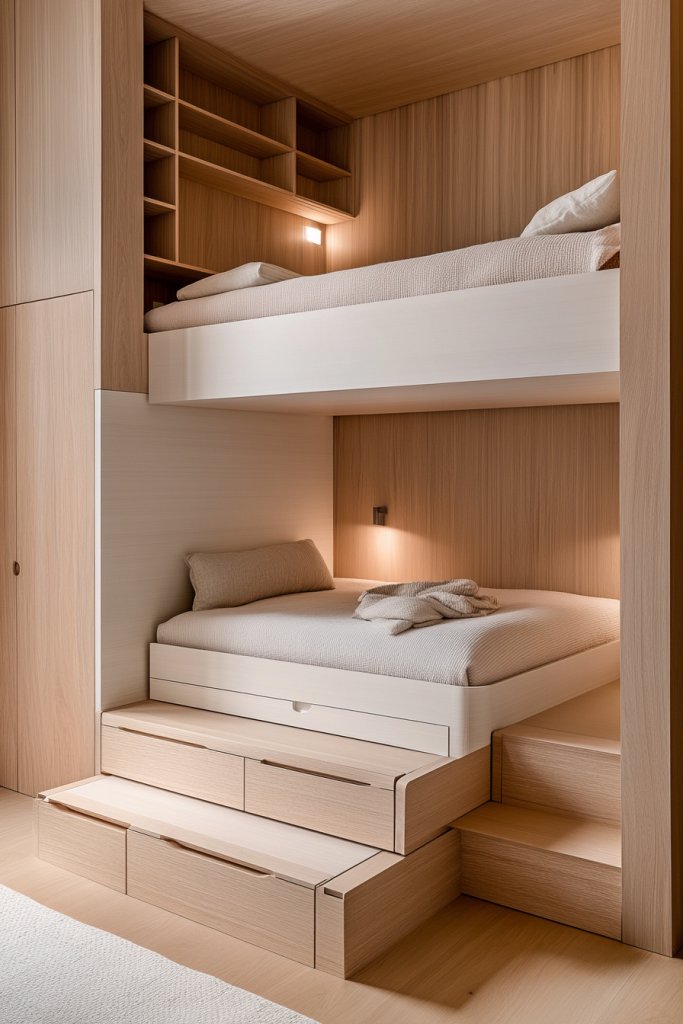
Living in a small room often feels like a constant battle between wanting space and needing storage. A cluttered, cramped environment can drain your energy and make relaxing impossible. You dream of a solution that clears the chaos without sacrificing style or comfort. The ideal answer is something that cleverly uses every inch, especially the vertical ones.
Imagine a sleek loft bed painted in crisp white or soft pastel that towers over a tidy workspace or cozy sitting area. Underneath, built-in drawers and shelves hold everything from clothes to books—neatly organized and out of sight. The textures include smooth wood or matte lacquer, complemented by soft textiles like a plush rug or a cozy throw blanket nearby. The whole setup feels modern, airy, and incredibly functional.
You can customize your loft bed with colorful paint, geometric patterns, or even add a small desk underneath for studying or working. For a more minimalist look, opt for a simple metal frame with clean lines. If space allows, incorporate a small reading nook or a mini workspace beneath it. During colder months, add layered textiles or a warm-toned rug for comfort; in summer, keep it light and breezy.
Start by measuring your space and choosing a sturdy, safe loft bed frame that fits your ceiling height. Decide what kind of storage you need—drawers, shelves, or both—and select a model that maximizes vertical space. Assemble the frame carefully, ensuring stability, then add storage solutions like baskets, containers, or custom shelving. Use wall anchors to secure shelves and prevent accidents. Keep the area under the bed accessible and organized with labels or dividers for easy maintenance.
Personalize with colorful bedding, decorative cushions, or a soft throw to make it inviting. You can also add a string of LED lights along the frame for a cozy glow, or hang a simple fabric curtain for privacy. Use baskets or fabric bins in matching colors to keep smaller items tidy. Incorporate a small plant or a decorative sculpture on the shelves for a touch of personality—just avoid restricted items!
Maximizing vertical space with a loft bed turns your tiny room into a functional haven. It proves that with a little creativity, small spaces can be both stylish and practical. Plus, it’s a timeless solution embraced by tiny home enthusiasts everywhere. Ready to elevate your room and reclaim your space?
2. Wall-Mounted Bed with Folding Mechanism for Flexibility
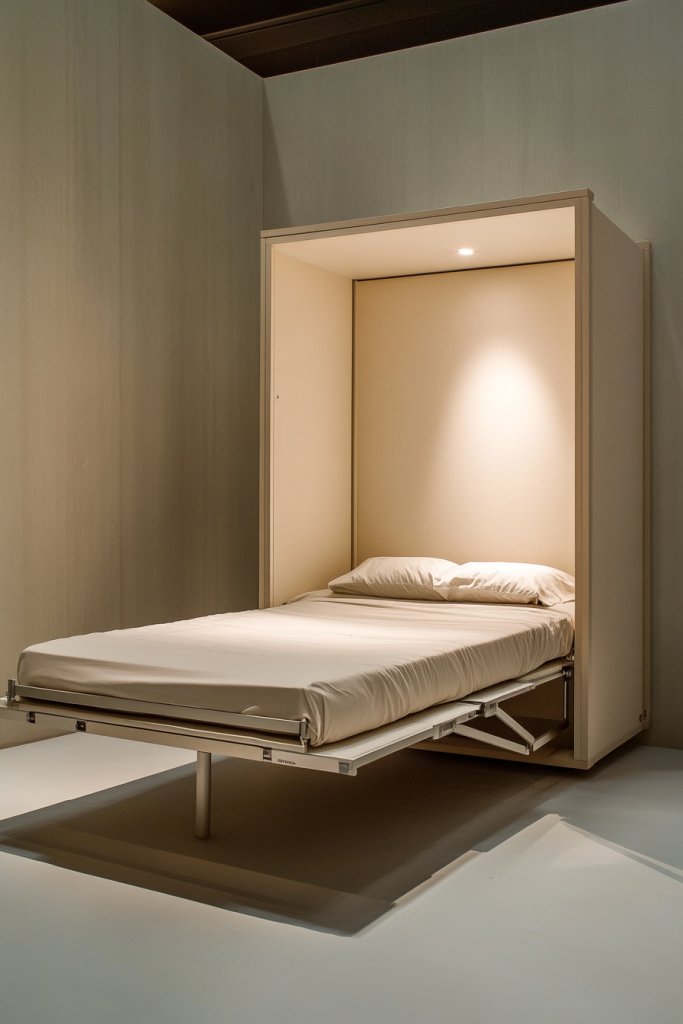
Small rooms often double as guest rooms or multifunctional spaces, leaving you juggling furniture and space constraints. Traditional beds eat up precious floor area, making it tough to switch between sleeping and working modes. The dream is a versatile setup that adapts to your needs without cluttering the room.
Picture a sleek wall-mounted bed in a neutral hue, folded up against the wall during the day, revealing a neat, open space. When it’s time to sleep, a simple pull-down mechanism reveals a comfortable mattress, surrounded by minimalist shelving and a foldable desk. The room feels bright and open, with the bed blending seamlessly into the wall, almost disappearing when not in use. The textures are smooth with soft fabrics on the bedding, complemented by a clean, modern finish.
Choose from various finishes—wood veneer, matte paint, or even mirrored panels—to match your decor style. For a more playful vibe, opt for colorful wall-mounted frames or textured wall panels that add depth even when the bed is folded away. In a small studio, combine this with foldable furniture and collapsible storage units for maximum flexibility. During different seasons, swap out bedding covers or add cozy throws for winter.
Begin by selecting a high-quality, wall-mount bed system with a sturdy frame and reliable folding mechanism. Ensure your wall can support the weight—if not, reinforce with additional studs or brackets. Install the folding bed according to manufacturer instructions, making sure it’s level and secure. Add a foldable desk or table that can tuck away when not in use, and incorporate wall-mounted storage for essentials. Test the mechanism thoroughly and keep safety in mind at all times.
Add a pop of color with vibrant bedding or decorative pillows that pop when the bed is folded down. You can also hang lightweight fabric curtains or install a small, decorative wall panel behind the bed for visual interest. Use wall-mounted baskets or slim cabinets to keep accessories organized. Personal touches like a small, foldable chair or a portable lamp can make the space functional and inviting.
This setup shows that small space living can be both adaptable and stylish. It’s perfect for guest rooms, studio apartments, or multi-use spaces, proving that clever design makes all the difference. With this approach, you can easily switch from a sleeping area to a workspace in seconds. Who knew that folding furniture could be so transformative?
3. Dual-Purpose Headboard with Shelving for Storage & Decor
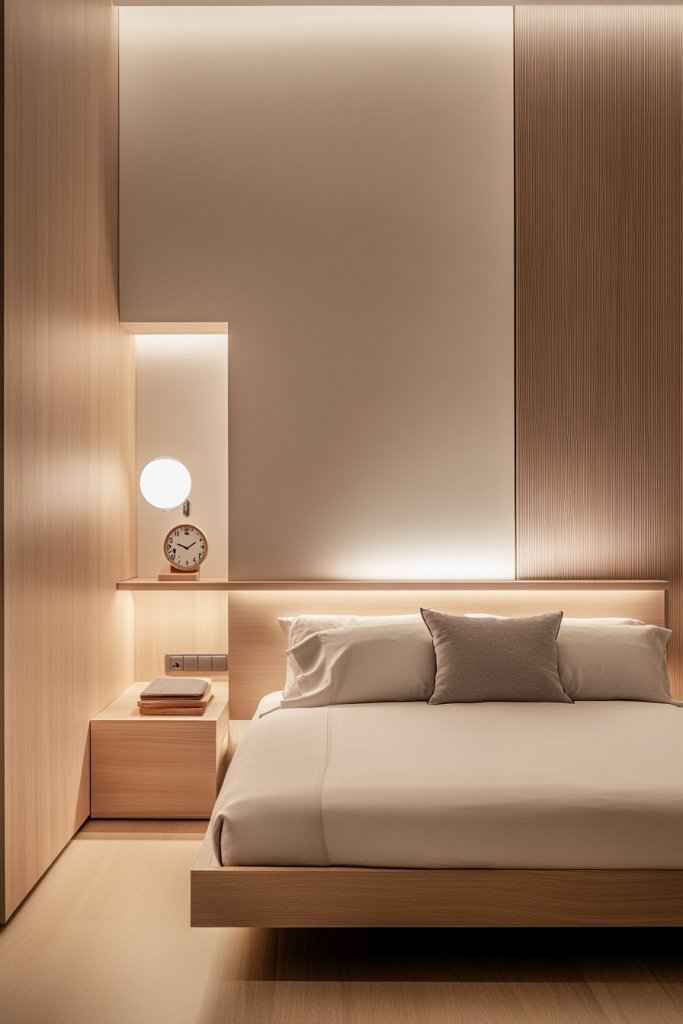
Small bedrooms often lack surface space for books, gadgets, or decorative items, leaving surfaces cluttered or empty. You want a solution that adds both function and style without taking up extra room. A dual-purpose headboard with built-in shelving offers a perfect blend, turning your bed into a mini storage unit.
Envision a sleek upholstered headboard with integrated open shelves made of natural wood or painted MDF. The shelves hold your favorite books, a small clock, or decorative accents—no need for side tables cluttering your space. The textures include soft fabric against the wall, with the shelves adding a touch of earthy warmth. The overall look is modern, clean, and highly functional.
Select a headboard with adjustable or modular shelves to suit your needs. For a minimalist style, keep the shelves sparse with only essential items. For a cozy vibe, add decorative baskets or fabric bins on the shelves to hide clutter. During different seasons, swap out decorative items or add seasonal textiles to complement the design.
Start by measuring your bed width and wall space to choose a headboard with appropriate shelf depth and height. Install the headboard securely into wall studs for stability. Arrange your items on the shelves, prioritizing essentials and avoiding overstuffing. Use small containers or file organizers on the shelves for better organization. Keep cords and chargers tucked away to maintain a tidy appearance.
Personalize with decorative textiles like a soft throw or cushion on the bed, and coordinate shelf items with your overall color scheme. Add a few framed photos or small sculptures if allowed—just avoid cluttering the shelves. Incorporate LED strip lighting underneath or along the edge of the headboard for a warm glow that highlights your decor.
This multi-functional headboard proves that small spaces can be both stylish and practical. It’s a clever way to keep essentials close at hand without sacrificing visual appeal. With a little DIY spirit, you can transform your room into a cozy, organized retreat that’s uniquely yours.
4. Platform Bed with Built-In Drawers for Seamless Storage
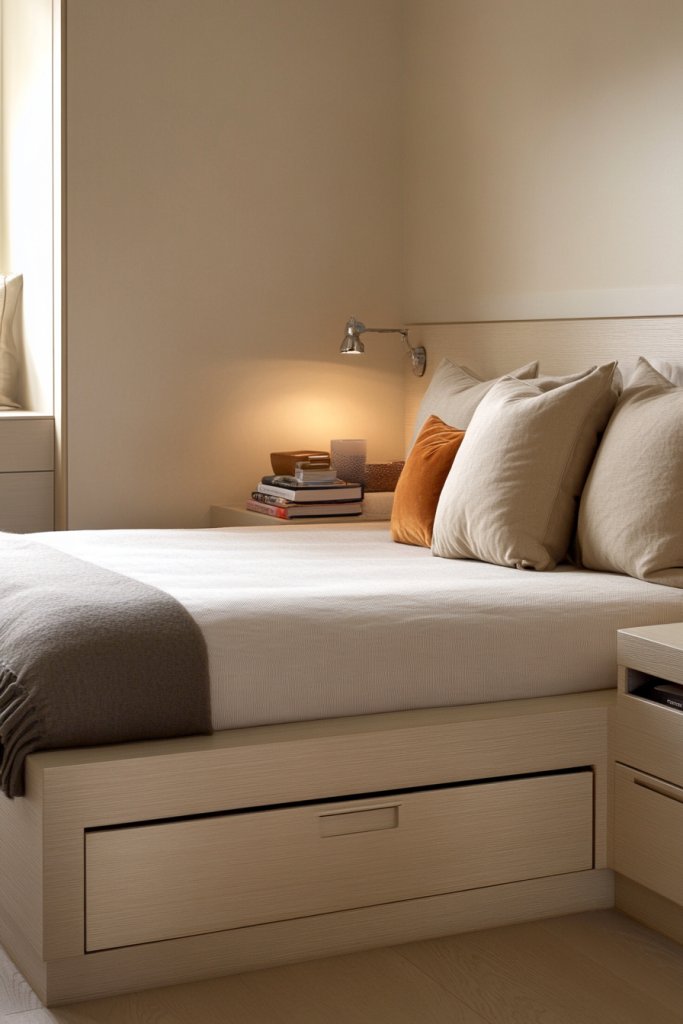
Cluttered bedrooms are the enemy of relaxation, especially when space is limited. You need a smart storage solution that doesn’t require extra furniture or cluttered closets. A platform bed with built-in drawers offers a sleek, integrated way to hide away essentials.
Picture a low-profile platform bed in a neutral tone, with deep drawers beneath the mattress for clothes, bedding, or shoes. The bed’s surface is smooth and firm, topped with soft linens and a cozy throw. The textured wood or painted finish complements the room’s decor, creating a seamless look that combines function with style. The space feels organized, calm, and intentionally designed.
Choose from various woods, painted finishes, or upholstered frames to match your aesthetic. For a minimalist look, opt for a simple, unadorned platform with hidden handles. If you love textures, add a soft bedspread or layered pillows—just keep the drawers clear of clutter for best effect. Seasonal updates can include changing bedding colors or adding decorative accents.
Start by measuring your space and selecting a platform bed with sufficient storage capacity. Assemble the bed frame according to manufacturer instructions, ensuring stability. Organize your items into the drawers using dividers or bins for easy access. Keep the area under the bed clear and clean to maximize visual harmony. Regularly check the hardware and clean the drawers for smooth operation.
Add a soft mattress topper, decorative pillows, or a textured bedspread to elevate the look. Use drawer liners or fabric inserts to keep items tidy inside. Incorporate a small bedside shelf or a wall-mounted lamp to keep the surface free of clutter. Personal touches like a favorite blanket or a decorative pillow can make it feel more inviting.
This approach proves that clever furniture choices can dramatically improve small room organization. It’s a space-saving win that makes your bedroom feel larger and more serene. With this setup, you’ll enjoy a clutter-free retreat designed just for you.
5. Floating Nightstands to Save Space & Add Style
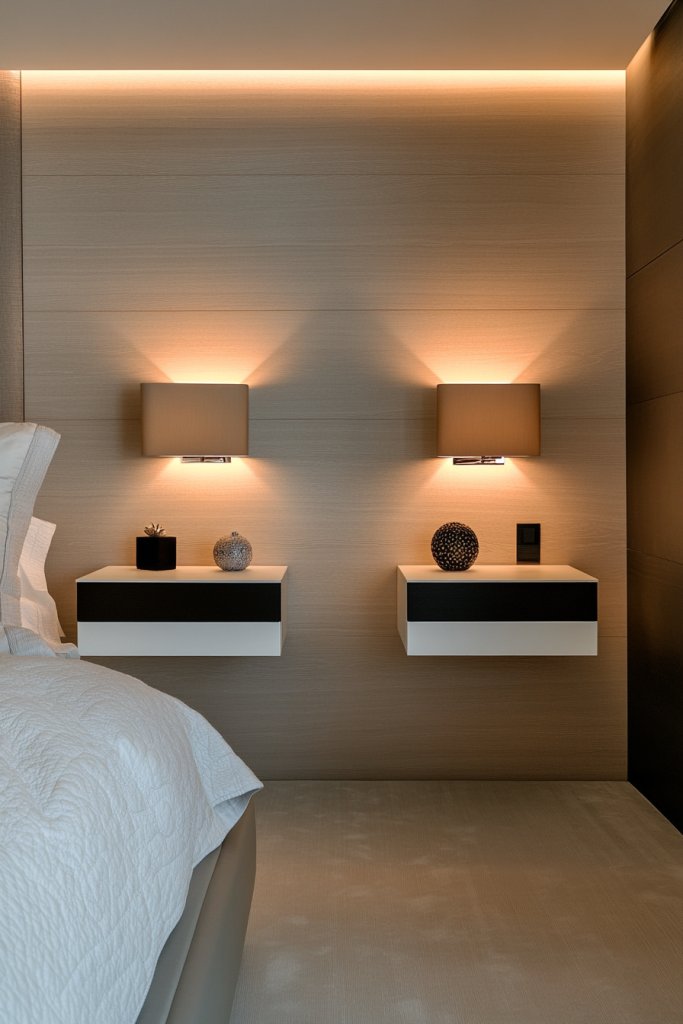
Traditional bedside tables can look bulky and take up valuable floor space, especially in tiny bedrooms. You want a stylish alternative that keeps essentials close without cluttering your floor plan. Floating nightstands are the perfect minimalist solution that maximizes space and adds a modern touch.
Visualize a sleek, wall-mounted shelf or small cabinet positioned beside your bed, with cords neatly tucked away behind it. The floating piece is in a matte black or wood finish, adding contrast against a light wall. It holds a few essentials—like a phone, a book, or a small decorative item—without overwhelming the space. The room feels more open, clean, and balanced, with the floating nightstand blending seamlessly into the decor.
Select floating nightstands with drawers for hidden storage or open shelves for display. Use colors that complement your wall or bedding, from bold shades to soft neutrals. During different seasons, change accessories or add a small decorative tray on top. For a cozy vibe, pair it with textured bedding and layered textiles—just keep surfaces clear of clutter.
Start by measuring the space beside your bed and choosing a floating nightstand that fits your needs. Install with wall anchors into studs or solid wall areas for stability. Keep the area underneath clear to enhance the illusion of spaciousness. Use cable management clips to hide cords and maintain a tidy appearance. Regularly dust and check the mounting hardware for safety.
Decorate the top with a small plant, a candle, or a decorative object to add personality. Change accessories seasonally or for special occasions. Use a stylish tray or organizer to keep small items tidy. Complement the look with matching wall art or a coordinated bedding set for a cohesive, personalized feel.
Floating nightstands prove that less is often more—saving space without sacrificing style. They create a clutter-free, modern vibe that works in any small bedroom. With a little effort, you can achieve a sleek, open look that feels both functional and beautiful.
6. Vertical Storage with Tall Shelving Units
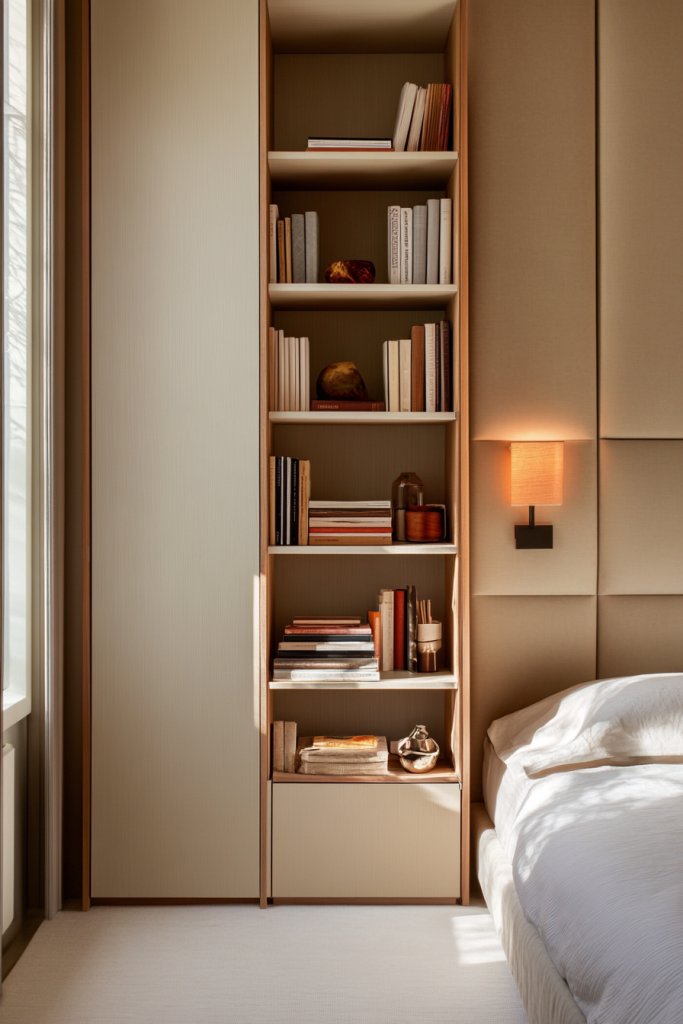
In tiny rooms, horizontal space is precious, but vertical space is often overlooked. Tall shelving units are a game-changer, allowing you to store more without sacrificing floor space. They’re perfect for organizing books, decor, or essentials, all while drawing the eye upward.
Imagine a slim, floor-to-ceiling bookshelf painted in a light color to reflect light and brighten the room. It’s filled with neatly stacked books, decorative boxes, and small baskets. The textures include glossy or matte finishes, with the shelves providing a mix of open and closed storage. The room feels taller and more expansive, with everything perfectly organized and accessible.
Opt for open shelving for easy access or add closed cabinets at the bottom for hidden storage. Use baskets or boxes on the shelves for a tidy look, and incorporate decorative elements like framed photos or textiles. During different seasons, swap out items to keep the space feeling fresh. Choose light colors to enhance the feeling of openness or bold hues for a striking statement.
Measure your wall height and width before selecting a tall shelving unit. Securely anchor the unit into wall studs to prevent tipping, especially if you have children or pets. Organize your items by category or frequency of use, placing the most-used at eye level. Add labels or color coding for quick identification. Regularly dust and rearrange to maintain a tidy, functional look.
Decorate the shelves with textiles, small sculptures, or decorative storage bins—just avoid clutter. Use LED strip lighting or small clip-on lamps to highlight your favorite items. Change shelf contents seasonally or for special occasions, and incorporate personal collections or heirlooms for a unique touch. Keep things fresh and inspiring.
Vertical storage solutions like tall shelves show that small rooms can be both functional and stylish. They help you organize without sacrificing precious floor space. With clever arrangement, your room will feel more open, organized, and inviting—proof that small doesn’t mean limited.
7. Multi-Functional Furniture: Bed with Desk or Dresser Combo
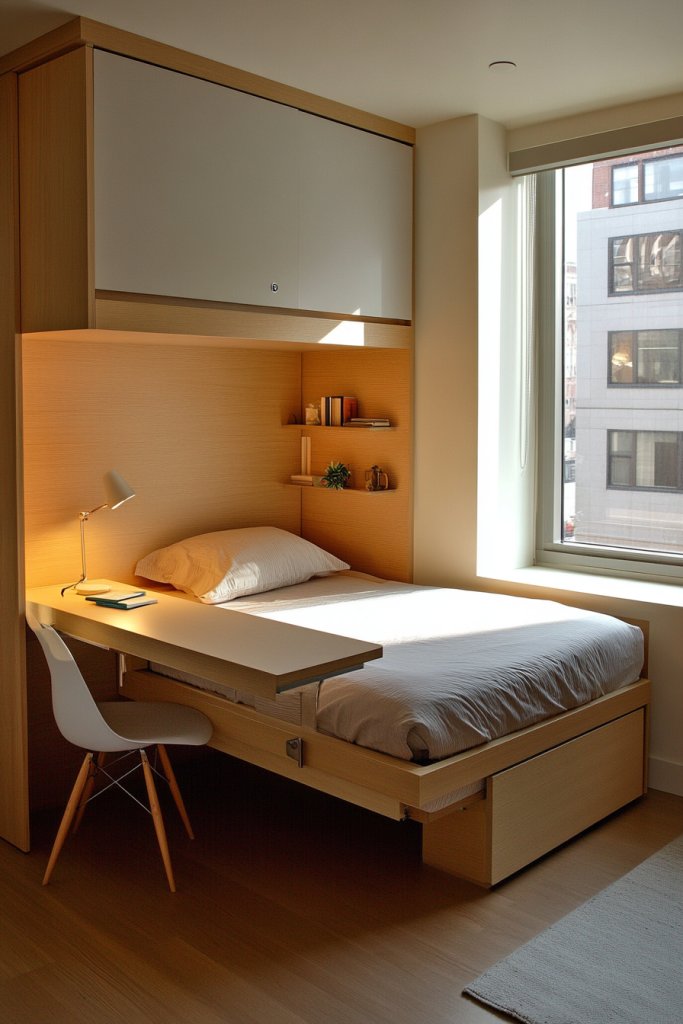
Small rooms often force you to choose between sleeping, working, or storing clothes, which leads to clutter and frustration. You need furniture that can do double duty, saving space while serving multiple functions. Multi-functional pieces are like the Swiss Army knives of small space living.
Picture a sleek bed with a built-in desk that slides out from underneath or folds down from the wall. Alternatively, a dresser with a fold-up work surface or additional storage compartments blends seamlessly into your room. The textures include woodgrain finishes, smooth surfaces, and soft bedding, creating a harmonious, clutter-free environment. The room looks streamlined, with everything having its place.
Choose a bed with an integrated desk for a compact workspace or a fold-down table that can be tucked away when not in use. Use a combination of drawers and open shelves for flexible storage. During different seasons, swap out desk accessories or add a small pinboard or whiteboard for planning. Keep the look fresh with colorful accessories or textiles that match your style.
Start with measuring your space and selecting multi-purpose furniture that fits comfortably. Install or assemble according to instructions, ensuring stability. Organize your work supplies in drawers or containers, and keep cables managed with clips or sleeves. Maximize efficiency by placing the furniture where it won’t block windows or doors. Regularly tidy to maintain a neat, functional space.
Add a comfortable chair or a stylish cushion for the workspace, and update your desk area with seasonal accessories or personal mementos. Use colorful storage bins or decorative wrapping for a personalized touch. Incorporate a small, portable lamp or LED strip lighting to create ambiance and improve functionality.
Multi-functional furniture demonstrates that small spaces can be versatile and stylish. It encourages creative solutions that make your room work harder for you. With these clever pieces, you’ll turn limited square footage into a dynamic, inspiring environment that adapts to your lifestyle.
8. Narrow Bed with Side Ledges for Minimalist Elegance
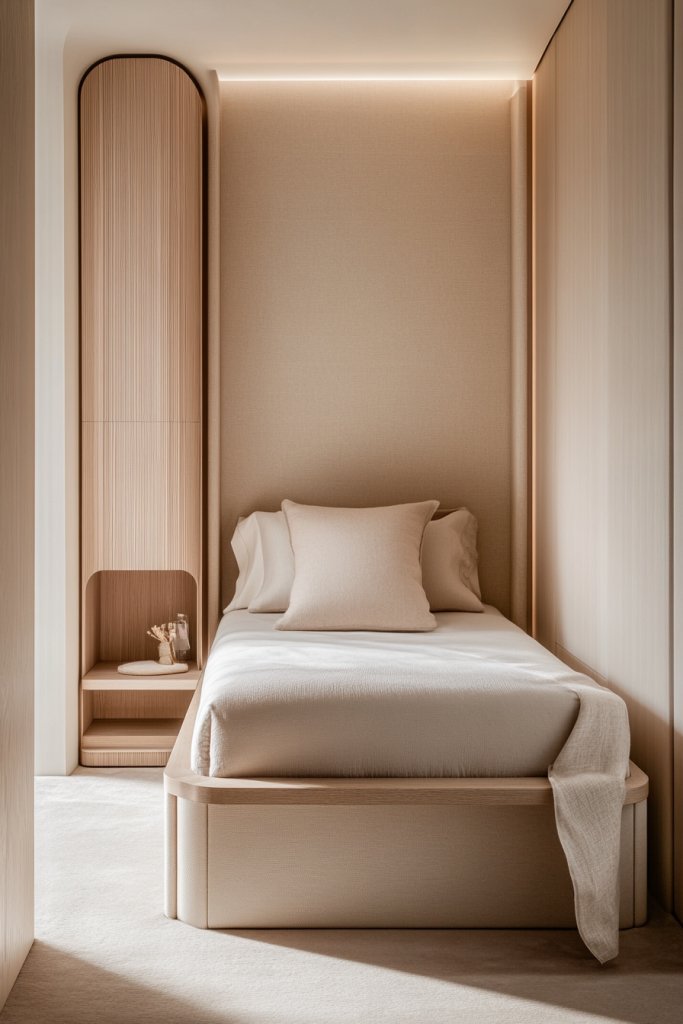
A bulky bed can dominate a small room, leaving little space for anything else. You want a sleek, minimalist sleeping solution that doesn’t overwhelm your limited space. A narrow bed with side ledges or built-in shelves offers a simple, stylish way to keep essentials close without clutter.
Visualize a slender, streamlined bed frame in a soft neutral tone, with narrow ledges on each side acting as nightstands. The textured bedding includes a light duvet and a few decorative pillows, adding a cozy feel. The ledges hold essentials like a book, a small clock, or a cup—keeping surfaces clear and organized. The overall look is modern, clean, and functional, with a sense of openness.
Choose beds with integrated side shelves or add floating ledges on either side for a customized look. Use light-colored linens and minimal decorative accents to enhance the room’s airy vibe. For seasonal updates, swap pillows or textiles, keeping the core design simple. You can also opt for a bed with a headboard that doubles as a shelf for additional storage.
Measure your space carefully to select a narrow bed that fits comfortably. Securely attach side ledges or install floating shelves at appropriate heights. Keep the surfaces clutter-free by organizing small items in containers or baskets. Use wall anchors and proper hardware for safety and stability. Maintain the setup with regular cleaning and occasional updates to accessories.
Personalize with soft bedding, textured throws, or decorative pillows that complement your decor. Use the ledges for small plants, art books, or decorative objects—just avoid too many to prevent clutter. Change textiles seasonally or add a string of fairy lights for ambiance, keeping the space inviting.
This minimalist approach shows that less really can be more, especially in small rooms. It creates a calm, organized environment that’s easy to maintain. With thoughtful touches, your tiny bedroom can feel like a serene retreat designed with purpose.
9. Sliding Door Closets to Maximize Entry Space
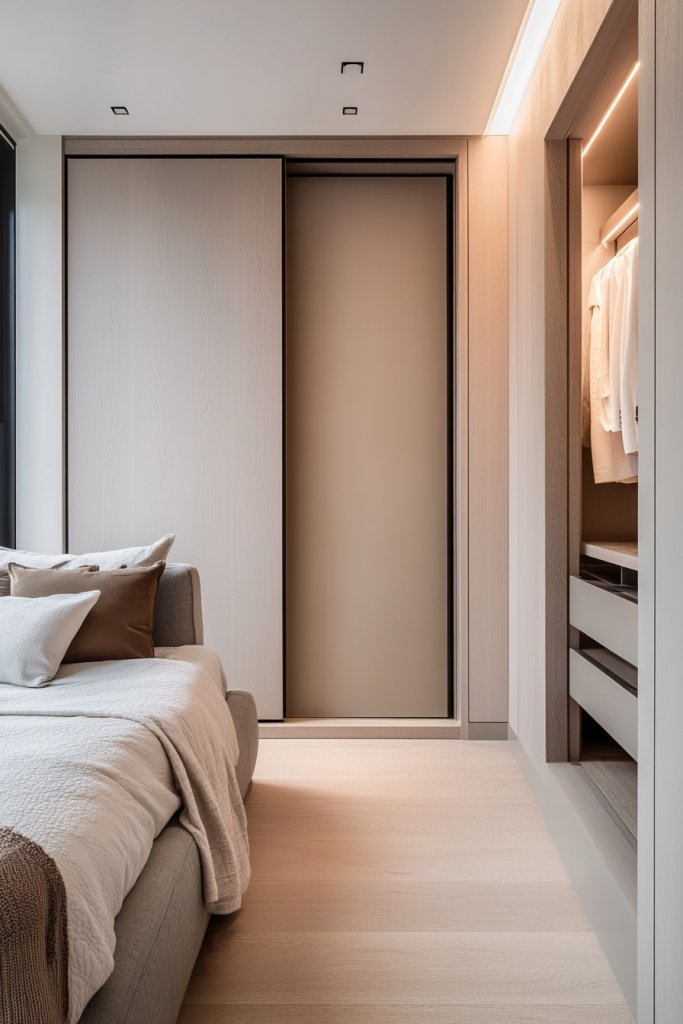
Traditional closet doors swing open and eat into your limited floor space, making small rooms feel even tighter. You need a smarter solution that keeps your wardrobe accessible without sacrificing precious room for movement. Sliding doors are the sleek answer to space-wasting door swings.
Imagine a closet with sleek, mirror-embedded sliding doors that glide smoothly open, revealing neatly organized clothing and accessories inside. The doors reflect natural light, making the room feel larger and brighter. The textures include glossy or matte finishes, with the mirrored surface adding a touch of elegance. The overall effect is a clean, uncluttered look that maximizes entryway efficiency.
Choose from mirrored, frosted, or wood-paneled sliding doors to match your decor. Use the inside of the closet for hanging space, shelves, or drawers, tailored to your storage needs. For seasonal updates, change the door finishes or add decorative hardware. Keep the exterior visually minimal for a streamlined look.
Measure your closet opening precisely before purchasing sliding doors or tracks. Install the tracks securely into the wall or ceiling, ensuring smooth operation. Keep the floor clear of obstacles and test the sliding mechanism multiple times. Organize your wardrobe with hanging rods, baskets, and dividers to optimize space inside. Regular maintenance includes cleaning the tracks and checking hardware for wear.
Decorate the closet doors with decals, film, or custom paint to add personality. Use the mirrored doors for dressing and grooming, and pair with stylish, space-saving storage solutions inside. Keep the exterior clean and reflective, and occasionally update hardware for a fresh look.
Sliding closet doors turn a typical small room into a sleek, modern space. They eliminate door swing issues and make the entry feel open and inviting. With this upgrade, your room becomes more functional and visually appealing—proof that smart design elevates tiny spaces.
10. Vertical Wall-Mounted Nightstands for Small Footprint
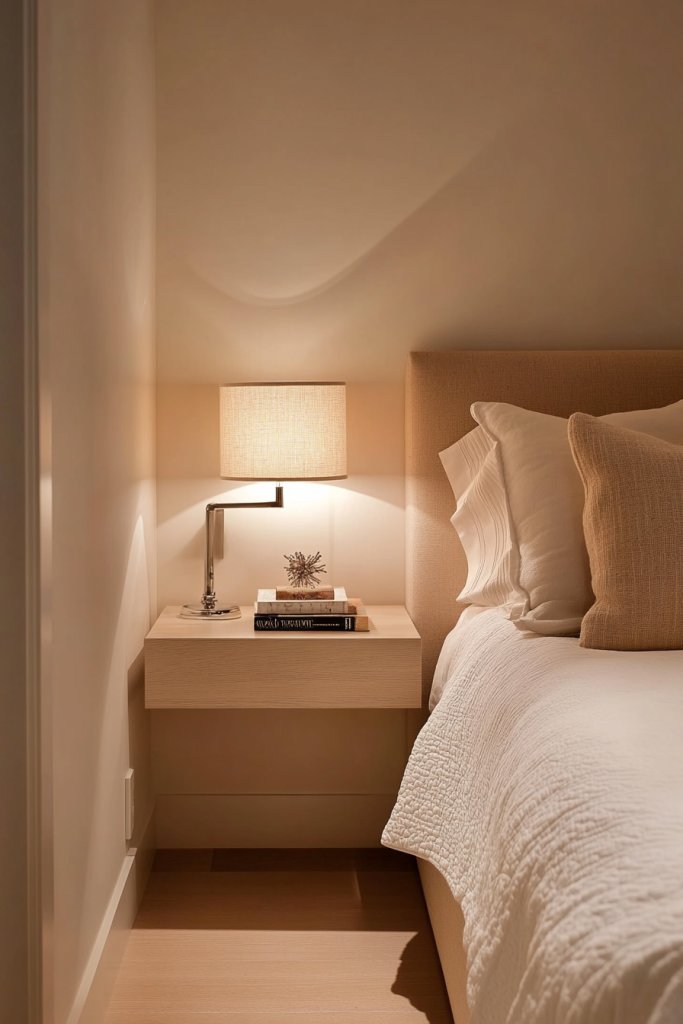
Cluttered nightstands can make a small bedroom feel claustrophobic and chaotic. You need a minimal, space-saving alternative that still keeps your essentials at hand. Wall-mounted nightstands are the perfect solution to keep floors clear and surfaces tidy.
Visualize a sleek, rectangular wall-mounted shelf in a matte black or natural wood finish, positioned beside the bed. It holds a small lamp, a book, and a glass of water—all neatly organized. The textured wall behind it adds visual interest, while the clear surface keeps clutter at bay. The room feels open, airy, and modern, with plenty of space to move around.
Choose floating nightstands with drawers for hidden storage or open shelves for display. Use contrasting or matching colors to create visual harmony with your bedding and walls. During different seasons, swap out accessories or update the wall color around the shelf for a fresh look. Combine with minimalist bedding and decor for a cohesive style.
Measure from the floor to the desired height, typically around bed height, and mark the position. Securely anchor the shelf into wall studs or use heavy-duty anchors for drywall. Organize items by size and function, keeping the top surface clear for essentials. Use cable clips or covers to hide cords and maintain a clean appearance. Regularly dust and check hardware for stability.
Decorate the shelf with small decorative objects, a scented candle, or a tiny plant—avoiding restricted items. Change accessories seasonally or for special occasions. Use a matching or contrasting paint color around the wall for added visual interest. Keep the setup simple, functional, and personalized.
Wall-mounted nightstands show that smart, space-efficient solutions can be both stylish and practical. They free up floor space for movement or additional furniture and make your room feel larger. A small change like this can have a big impact on your room’s overall vibe and usability.
11. Zone the Room with Rugs and Furniture Placement
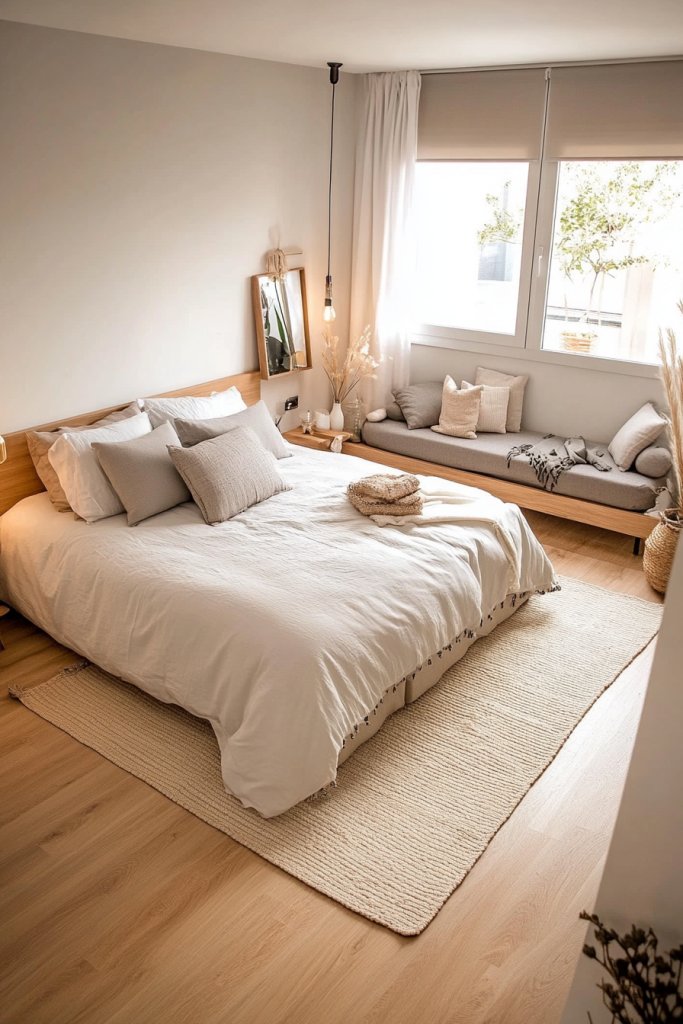
In small rooms, a lack of clear zones can make the space feel cluttered and chaotic. You want to create designated areas for sleeping, working, and relaxing without adding extra furniture. Strategic placement and rugs can visually separate different functions and add warmth.
Picture a small room divided into zones with a soft, textured rug under the bed and a smaller, contrasting mat near a tiny desk or reading nook. Furniture placement guides the eye and creates visual boundaries. The textures include plush rugs, sleek furniture, and layered textiles that add depth and comfort. The overall effect is a well-organized, inviting space that feels larger and more functional.
Use different rug sizes or patterns to define zones—geometric patterns for a modern look or layered textures for coziness. Position furniture to create distinct pathways and avoid cluttered walkways. During different seasons, swap rugs or reposition furniture to refresh the space. Incorporate multi-purpose furniture to maximize each zone’s utility.
Start by identifying the main functions of your room and planning zones accordingly. Place the bed against the longest or most unobstructed wall. Use area rugs to define the sleeping zone and a smaller one for the workspace or lounge area. Arrange furniture to promote easy movement and clear pathways. Use visual cues like rugs or lighting to reinforce zones, and keep clutter out of walkways.
Layer rugs with different textures or colors to add personality. Personalize each zone with textiles, throws, or decorative pillows tailored to each function. Use lighting—like small lamps or sconces—to highlight different areas. Seasonal accents, such as cozy throws or lighter textiles, keep the zones feeling fresh.
Zoning your small room with rugs and smart furniture placement transforms chaos into calm. It visually expands the space and creates a sense of order. With a little planning, your tiny room can feel much larger and more functional—proof that thoughtful design makes all the difference.
12. Create an Open-Plan Layout with Minimal Furniture
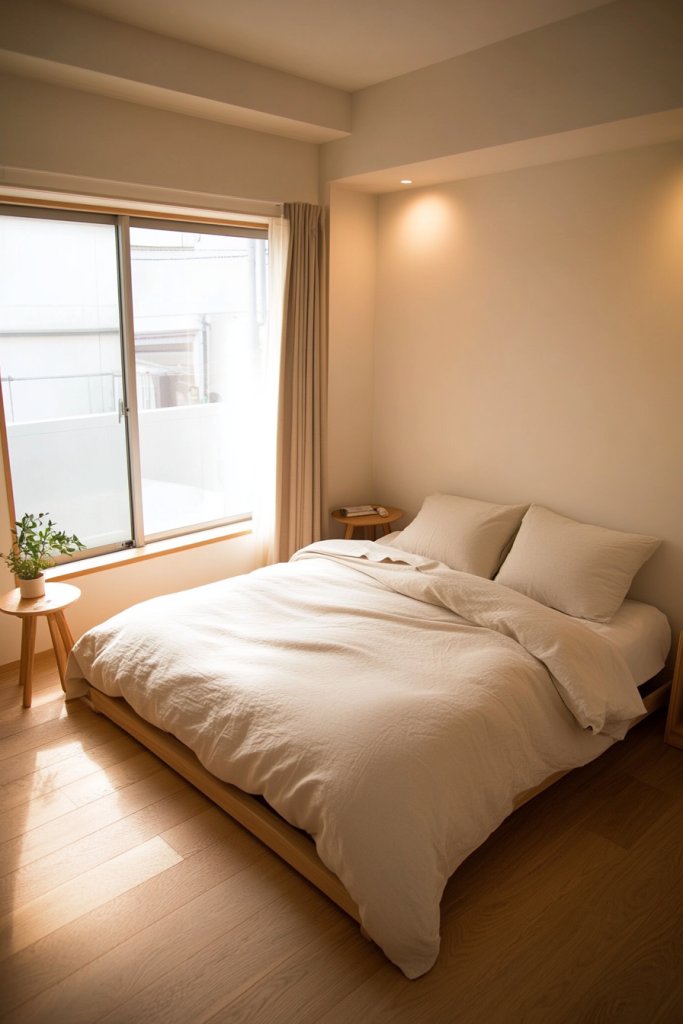
In tiny bedrooms, cluttered furniture arrangements can make the space feel suffocating. You want an open, breathable layout that maximizes every inch and avoids feeling cramped. An open-plan approach with minimal furniture creates a sense of freedom and spaciousness.
Envision a room where only essential furniture is present—a low-profile bed, a small floating desk, and perhaps a compact wardrobe—arranged to keep pathways clear. The textures are simple: soft bedding, smooth flooring, and subtle textiles that add warmth without bulk. The overall ambiance is bright, uncluttered, and tranquil, with plenty of negative space enhancing the sense of openness.
Opt for multi-functional furniture that combines functions—like a bed with storage drawers or a fold-down desk. Keep decor minimal and cohesive, with a neutral palette to expand the visual space. Use open shelving or wall-mounted organizers instead of bulky dressers. Seasonal changes can include swapping textiles or adding decorative accents that keep the room feeling fresh.
Start by decluttering and removing unnecessary furniture. Arrange your essentials along the longest wall, leaving the center open. Use low furniture to keep sightlines unobstructed. Incorporate wall-mounted storage to free up floor space. Keep the pathways clear for easy movement, and choose multi-purpose pieces to serve several needs without crowding.
Use a monochromatic color scheme or subtle patterns to unify the space visually. Add personal touches with textiles, artwork, or small decorative objects—just keep clutter out of sight. Seasonal updates, like new curtains or throws, can refresh the space without adding bulk.
An open-plan layout demonstrates that minimalism can be both practical and stylish. It makes your small room feel more expansive and peaceful. With intentional furniture choices, you turn a cramped space into a calm sanctuary that’s a joy to live in.
13. Incorporate Fold-Down or Collapsible Furniture Pieces
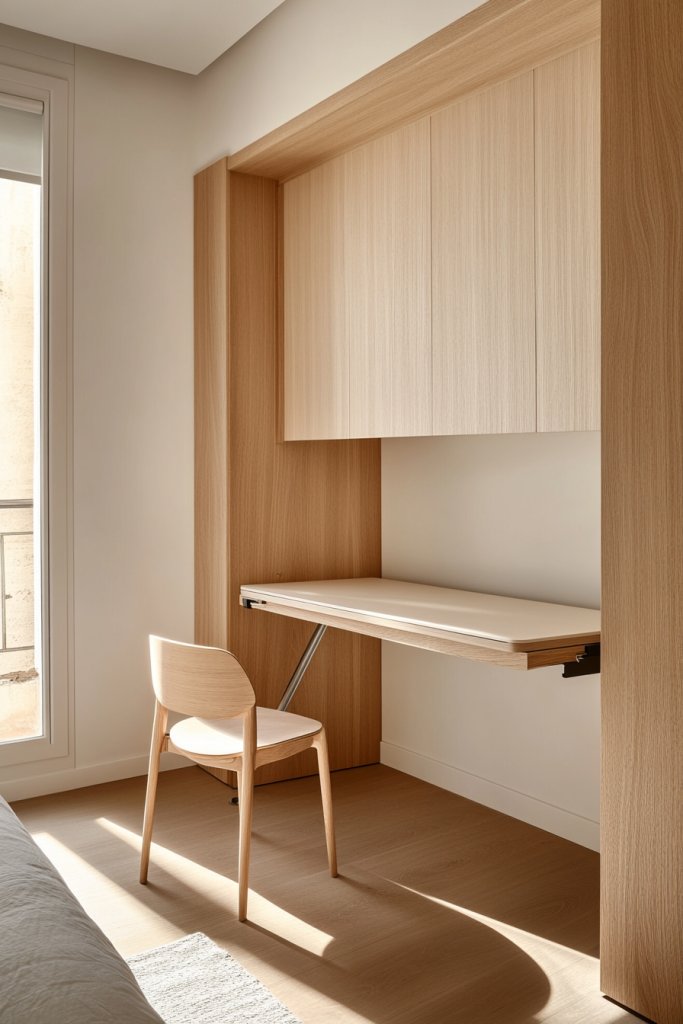
Small rooms often need to serve multiple functions, but bulky furniture makes this difficult. You want versatile pieces that can hide away when not in use, freeing up space for other activities. Fold-down or collapsible furniture offers a clever solution for maximizing functionality.
Imagine a wall-mounted fold-down desk that swings down when needed and tucks away seamlessly when not. Nearby, a foldable chair stored in a wall niche, and a collapsible bed that unfolds from the wall, all in a sleek, neutral finish. The textures include smooth wood, matte paints, and soft textiles that add comfort. The room transforms from a compact workspace to a cozy sleeping area effortlessly.
Choose foldable tables for dining or work, and fold-away beds or sofas for sleeping. Use wall-mounted brackets or tracks for stability and smooth operation. During different seasons, swap out textiles or add small decorative accents to keep the space inviting. Keep the mechanisms well-maintained for ease of use.
Start by selecting quality fold-down furniture suited to your space and weight requirements. Install sturdy wall brackets, ensuring they are anchored into studs. Organize your space so that items like chairs or beds fold away with ease. Use wall space efficiently by adding hooks or small shelves for accessories. Test all mechanisms regularly for safety and longevity.
Decorate fold-down surfaces with textiles, or add wall decals or artwork that become visible once the furniture is unfolded. Keep accessories minimal to avoid clutter. Use seasonal textiles or color schemes to refresh the look. Personal touches like a small pillow or a decorative tray can make foldable furniture feel more homey.
Fold-down furniture proves that small spaces can be highly adaptable without sacrificing style. It’s a smart, space-saving approach embraced by tiny home enthusiasts worldwide. With a little effort, you can create a flexible living area that caters to your needs and style.
14. Utilize Niche Spaces for Clever Storage Solutions
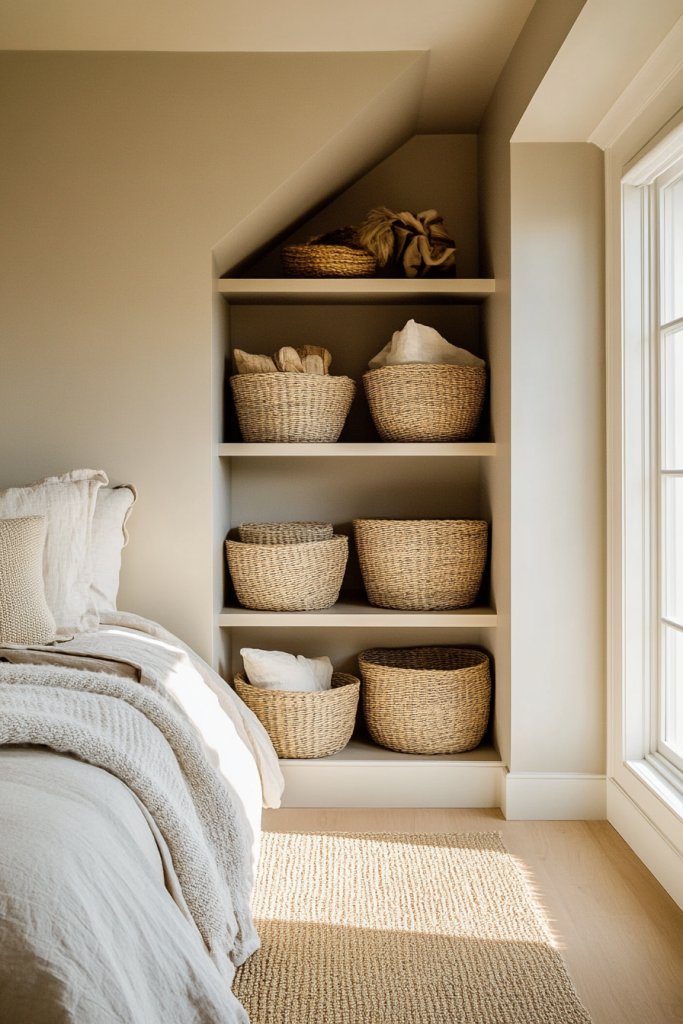
Unused nooks, alcoves, and small recesses are often overlooked but hold potential for smart storage. In tiny rooms, these spaces can be transformed into functional zones, reducing clutter and maximizing every inch. The challenge is to turn awkward gaps into attractive, useful features.
Visualize a small niche beneath a window, fitted with custom shelving holding books, decor, or storage bins. The textures include smooth painted walls, wooden shelves, and soft textiles on a nearby chair or cushion. The overall look feels integrated and intentional, with hidden storage making the room appear larger and more organized.
Design niches with built-in shelves, cubbies, or drawers, tailored to your needs. Use colorful boxes or baskets for hidden storage, and incorporate decorative elements like small sculptures or framed photos (avoiding restricted items). During different seasons, update items or change the arrangement for a fresh look.
Start by identifying niches, alcoves, or small spaces that can host storage. Measure dimensions carefully and build or install custom shelving or cabinetry. Use organization tools like dividers, bins, or pull-out trays for easy access. Secure all elements properly and keep frequently used items within easy reach. Regularly declutter and reorganize for optimal efficiency.
Decorate shelves with textiles, small decor, or personal items that reflect your style. Use vibrant or textured containers to add visual interest and hide clutter. Seasonal decorations or themed storage can make the space feel dynamic. Keep the look cohesive with your overall room palette.
Transforming niches into storage showcases resourcefulness and creativity. It turns overlooked spaces into assets, making your tiny room more functional. With clever solutions, small spaces become highly personalized retreats that feel thoughtfully designed.
15. Use Overhead Space for Hanging Storage or Lighting
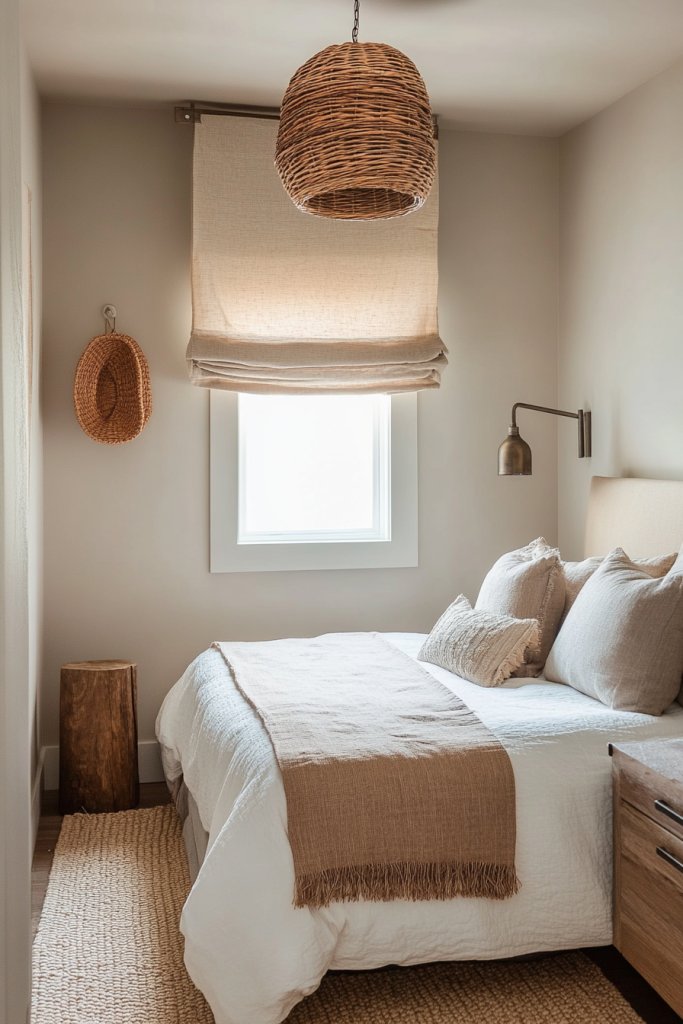
In small rooms, floor and wall space are at a premium. To free up surface area, you need to think vertically—especially overhead. Hanging storage or lighting can create a clutter-free environment while adding a stylish touch. The goal is to utilize ceiling space efficiently without making the room feel crowded.
Picture ceiling hooks with hanging baskets, storage bins, or lightweight decor. Pendant lights or chandeliers in sleek designs cast soft glow, illuminating the space without occupying valuable surface area. The textures include woven baskets, smooth metal fixtures, and soft fabrics in the textiles below. The room feels taller and brighter, with functional elements integrated seamlessly into the ceiling.
Choose hanging baskets or hooks for storage of accessories, or install pendant lights with dimmable options for ambiance. Use adjustable cords or chains for flexibility. During different seasons, swap out textiles or decorative elements hanging from the ceiling. Keep the setup simple and avoid overcrowding to preserve the open feeling.
Start by installing ceiling hooks into sturdy joists or anchors, ensuring they can support the weight. Hang storage baskets, organizers, or lighting fixtures at appropriate heights. Use cable management clips or sleeves to hide cords and create a tidy appearance. Keep pathways clear beneath to maintain a sense of openness. Regularly check hardware integrity.
Decorate hanging elements with seasonal textiles, fabrics, or lightweight decor to reflect your style. Use different textures and colors for visual interest. Incorporate dimmable lighting or fairy lights for a cozy atmosphere. Replace or update hanging items seasonally to keep the space fresh.
Ceiling-based solutions demonstrate that small spaces benefit from creative, multi-dimensional thinking. Overhead storage and lighting free up valuable room for movement and comfort. With simple installations, your tiny room becomes more functional and inviting—proof that the sky’s the limit.
16. Position Bed Against a Wall to Maximize Central Space
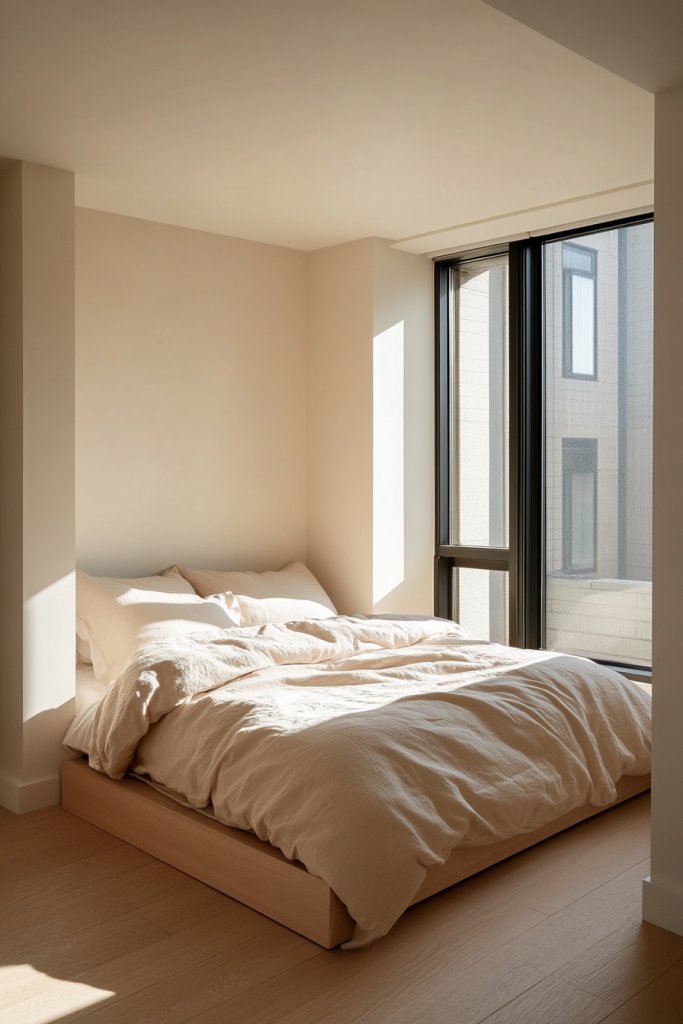
In tiny rooms, the way you position your furniture can make or break the feeling of spaciousness. A bed that sprawls across the middle of the room eats up precious space and blocks natural flow. Placing the bed against a wall is a simple strategy to open up the center and create a more inviting environment.
Envision a bed flush against the longest wall, with a clean, simple headboard in a neutral fabric or wood. The surrounding space is open, with a small nightstand and minimal decor. The textures include soft bedding in calming tones, contrasted with smooth wall finishes. The room feels larger, uncluttered, and designed with intention, with ample space for movement and additional furniture.
Choose a bed with a built-in headboard or a minimalist frame to keep the look sleek. Add floating shelves or wall-mounted lighting for essentials, freeing up surface space. For a cozy vibe, layer textiles and add a textured blanket or pillows. Seasonal updates can involve changing bedding colors or adding decorative pillows for a fresh look.
Start by measuring your space to choose a bed size that fits comfortably against the wall. Position the bed to maximize walking room and access to windows or doors. Use wall-mounted storage or slim furniture to keep the room feeling open. Keep pathways clear and avoid placing large furniture in the center. Regularly tidy to maintain a streamlined, spacious appearance.
Personalize with decorative textiles, small wall art, or a cozy throw. Use a matching or contrasting color scheme for the bedding and walls for visual cohesion. Incorporate lighting—such as wall sconces or a small bedside lamp—to enhance ambiance. Seasonal textiles or accessories keep the space feeling fresh.
Positioning the bed against a wall is a fundamental yet powerful space-saving move. It creates a more open, breathable environment, transforming your tiny room into a comfortable retreat. With this simple change, you’ll enjoy a room that feels much larger and more functional.
17. Incorporate Foldable or Modular Furniture for Flexibility
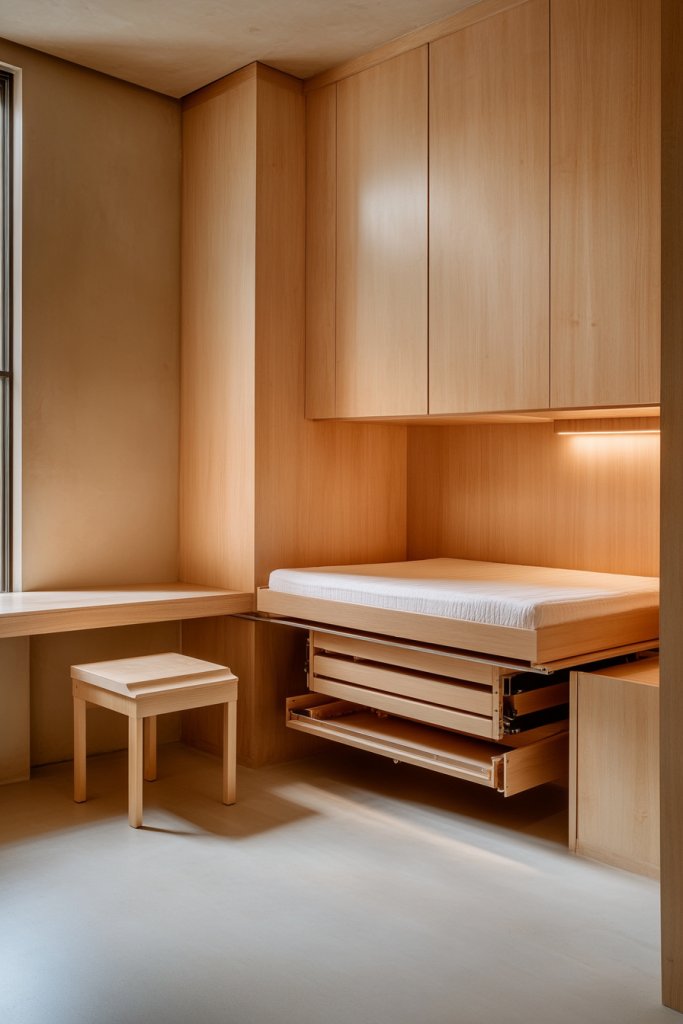
In small rooms, flexibility is everything. Fixed furniture limits your options and makes adapting to changing needs a nightmare. Foldable or modular furniture solutions empower you to reconfigure your space on the fly, turning chaos into calm.
Imagine a modular sofa that can be rearranged into a bed or separated into individual seats, all in a sleek, neutral fabric. A foldable desk tucks into a wall recess, ready to deploy when needed. The textures include smooth wood, soft upholstery, and lightweight textiles. The room feels versatile, functional, and effortlessly adaptable, with furniture that responds to your lifestyle.
Choose furniture with multi-configuration options—like stackable storage units, fold-up beds, or extendable tables. Use lightweight designs for easy movement and adjustability. During different seasons or activities, reconfigure the furniture to suit your needs—such as creating a home office or a guest sleeping area. Keep accessories simple to maintain a clean look.
Start by selecting modular or foldable furniture suited to your space and needs. Ensure mechanisms are easy to operate and durable. Arrange the pieces to maximize open space when not in use, and consider integrating storage compartments. Use casters or lightweight materials for easy repositioning. Regularly assess and reconfigure to keep the space fresh and functional.
Personalize with textiles, cushions, or accessories that match your style. Add a few decorative items or lighting that can be easily moved or tucked away. Seasonal updates like new covers or accessories can keep your space feeling lively and new. Use color schemes or patterns that reflect your personality.
Modular and foldable furniture solutions show that adaptability and style can coexist. They allow your small room to evolve with your needs, making every inch work harder. With this approach, your space becomes a flexible, inspiring environment that adapts to your life.
18. Minimalist Design with Hidden Storage for Clutter-Free Serenity
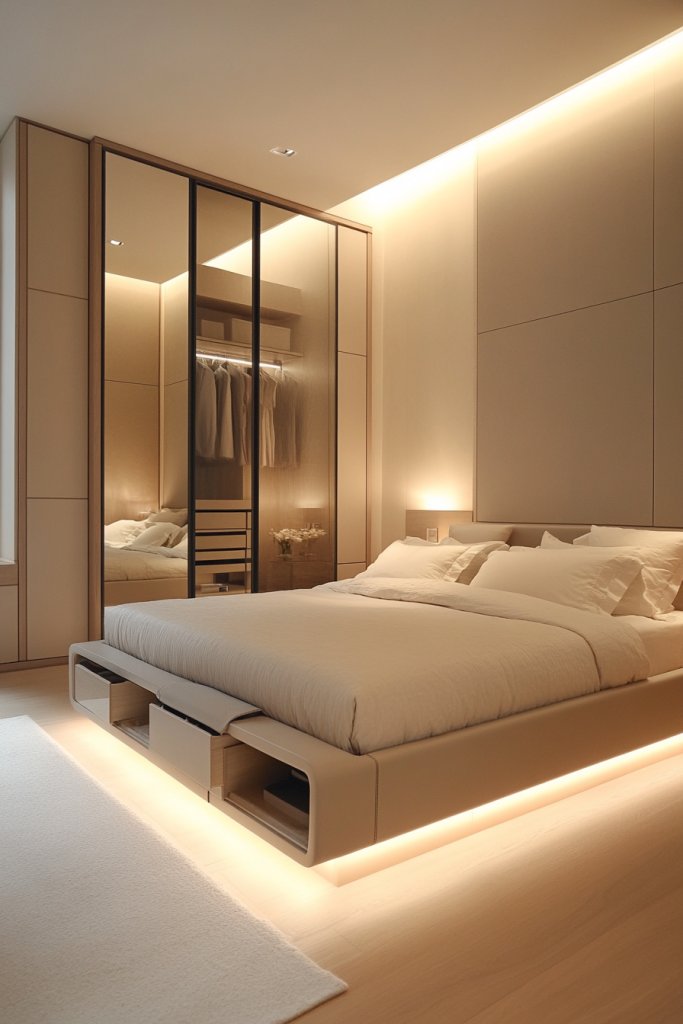
Clutter in small rooms quickly turns into chaos, making relaxation impossible. You crave a clean, calm environment where everything has a place, but without sacrificing style. Minimalist design with hidden storage offers a way to keep your space serene and organized.
Visualize a bedroom with sleek, handleless furniture that integrates storage compartments seamlessly. A bed with drawers beneath or a platform with hidden cubbies keeps clutter out of sight. The textures include matte finishes, smooth surfaces, and soft textiles that add warmth without visual clutter. The overall look is calm, tidy, and effortlessly elegant.
Use furniture with concealed compartments or drawers to hide everything from clothes to accessories. Keep surfaces clear and decorate with a few carefully selected textiles or decor items. During different seasons, update textiles or add subtle accents to refresh the look. Minimalist color palettes—white, gray, or muted tones—enhance the feeling of calm.
Start by decluttering and choosing furniture with built-in storage options. Install handles flush with the surface or opt for handleless designs for a sleek look. Keep frequently used items accessible; store seasonal or rarely used items in hidden compartments. Use organizers or dividers inside drawers for better order. Regularly maintain and tidy to preserve the minimalist aesthetic.
Add textures through textiles like a soft throw, layered cushions, or a plush rug. Personalize with subtle accents—like a small sculpture or a decorative tray—keeping clutter hidden. Use lighting strategically—like concealed LED strips—to highlight clean lines and add warmth. Keep decoration minimal but meaningful.
A minimalist, hidden-storage approach proves that less is often more in small rooms. It creates a peaceful sanctuary and reduces stress caused by clutter. With thoughtful organization, your tiny space can feel expansive, calm, and beautifully curated.
19. Use Color and Lighting to Enhance Room Perception
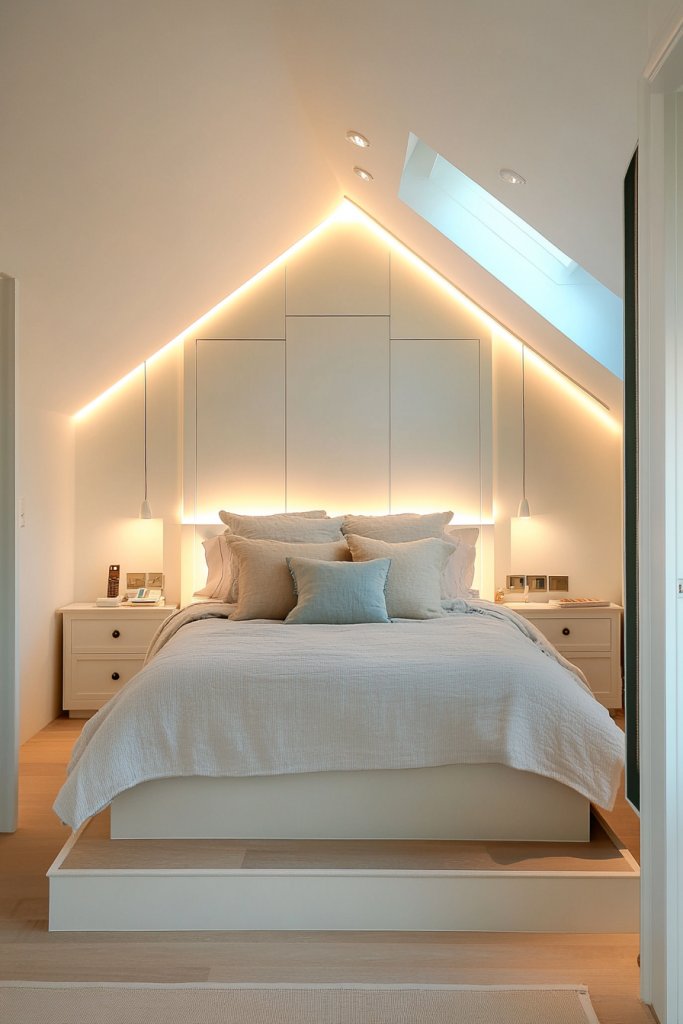
Dark colors and poor lighting can make even the largest rooms feel cramped and gloomy. In small bedrooms, the right color palette and lighting scheme can dramatically change how spacious and inviting your space feels. Bright, airy rooms boost mood and make everything seem larger.
Imagine walls painted in light, neutral tones like soft beige or pale gray that reflect natural and artificial light. Layered lighting includes a combination of ceiling fixtures, sconces, and task lights to eliminate shadows. Textures like crisp linens and smooth finishes complement the bright, open atmosphere. The room feels fresh, warm, and expansive, with light bouncing freely.
Use light colors on walls and furniture to maximize brightness. Incorporate layered lighting—ambient, task, and accent—to create depth and warmth. During darker months, add warm-toned bulbs or string lights to keep the space lively. Use reflective surfaces, like mirrors or glossy finishes, to amplify light and space.
Start by choosing a light color scheme for walls and furniture. Install layered lighting, starting with ceiling fixtures, then adding wall sconces or clip-on lamps. Use task lighting for reading or working areas and ambient lighting for relaxation. Incorporate mirrors strategically to reflect light and create the illusion of space. Regularly clean fixtures and surfaces to maintain brightness.
Personalize with textiles—curtains, bedding, or cushions—in light, neutral shades. Add a few decorative elements in complementary pastel or metallic tones for visual interest. Change lighting temperatures seasonally to adapt to mood or weather. Keep the room uncluttered to allow light to flow freely.
Using color and lighting strategically transforms small spaces into bright, welcoming retreats. It’s an accessible way to make your room feel larger and more comfortable. With simple adjustments, your tiny bedroom can radiate positivity and openness.
20. Leverage Under-Window Space for Seating or Storage
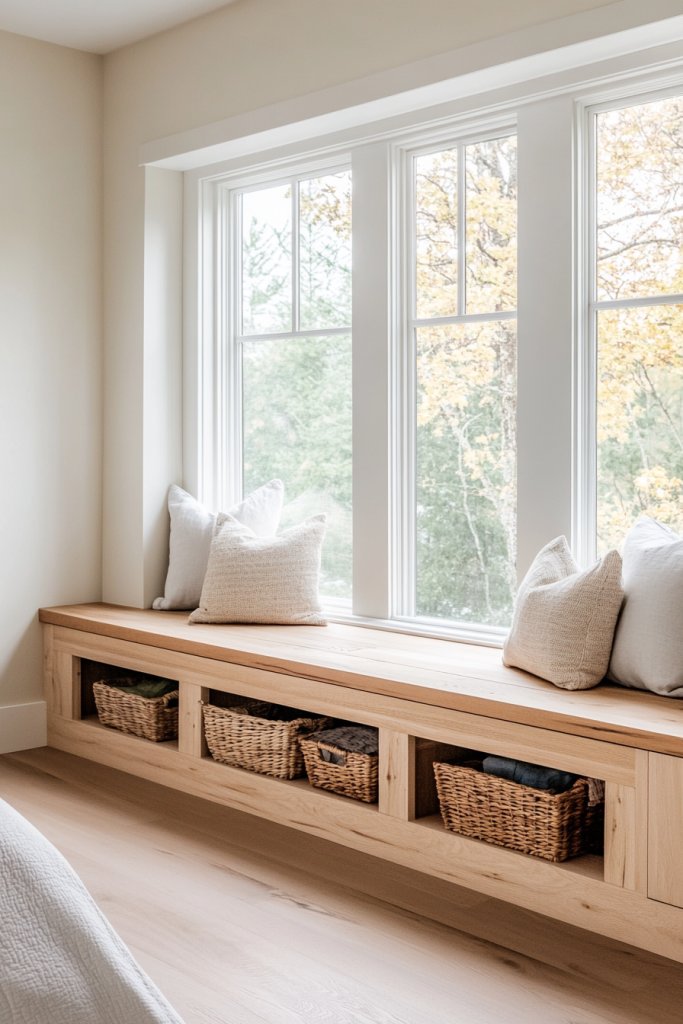
Under-utilized window spaces in small rooms are often ignored, but they hold potential for extra seating or storage. In tiny bedrooms, clever use of this space can add functionality without crowding the room. The challenge is to turn awkward gaps into valuable assets.
Picture a built-in bench with a soft cushion beneath a window, providing a cozy reading nook or extra seating. Storage drawers or baskets fit neatly underneath, hiding clutter out of sight. The textures include wood or painted finishes with plush textiles on the cushion and layered curtains. The overall vibe is inviting, practical, and space-efficient.
Use custom-built window seats with hidden compartments or add storage baskets underneath. Decorate with textiles matching your overall scheme—think soft cushions or a textured throw. During different seasons, swap out cushions or add a small side table for versatility. Keep window treatments light and airy to maintain openness.
Measure the space accurately to build or buy a suitable window seat or storage unit. Securely attach the seat to the wall or floor, and add a comfortable cushion or fabric cover. Use baskets or drawers underneath for hidden storage, organizing items for easy access. Ensure the setup enhances natural light and doesn’t block airflow. Regularly clean and maintain for longevity.
Add decorative cushions, a textured throw, or seasonal accents to make the space inviting. Incorporate small plants or decorative objects (avoiding restricted items) to personalize. Change textiles seasonally or for special occasions to keep the nook fresh. Use matching or complementary colors to tie the look together.
Using under-window space creatively shows how small areas can serve multiple functions. It increases seating and storage in a subtle, stylish way. With this simple trick, your tiny bedroom becomes more comfortable, functional, and personalized—proof that clever design transforms space.
Conclusion
With a diverse array of bedroom layouts for small rooms ideas, you now have plenty of inspiration to refresh your space. These clever designs can turn even the tiniest rooms into functional and inviting retreats. Don’t hesitate to try out these ideas and customize them to fit your style—your perfect small bedroom is just a layout away! Take action today and create a space where comfort and style go hand in hand.
Leave a Reply